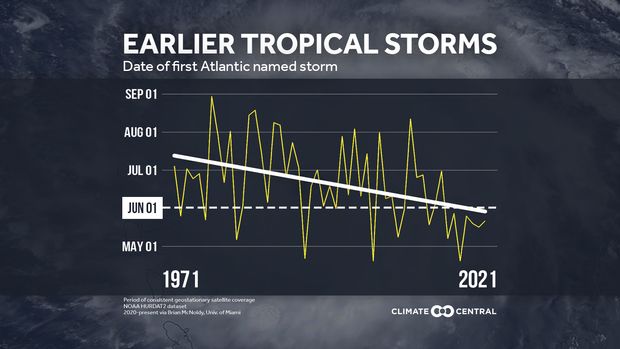Fast-moving Tropical Storm Elsa hit the New York City region with torrential rains and high winds, then headed up the East Coast on Friday.
Wind speeds had ticked down from overnight readings as high as 78 mph (126 kph) in coastal New Jersey that appeared to be “associated with nearby tornadoes,” the National Hurricane Center said in a morning update.
Heavy rains were causing potential traffic hazards in New York City and nearby suburbs, which were already reeling from a deluge Thursday that flooded roads and at least one subway station, the Associated Press reported. Up to 6 inches (15 centimeters) of rain was possible in some areas Friday. The hurricane center said a tornado or two was possible through early afternoon Friday over parts of Long Island and southeastern New England.
Elsa hits about a month into an Atlantic hurricane season that runs through November and is predicted to pack another above-normal storm tally as the impact of climate change brings fresh attention to deadly and destructive weather events, especially flooding.
Forecasters at the National Oceanic and Atmospheric Administration’s (NOAA) Climate Prediction Center see a 60% chance of an above-normal season. Last year produced a record 30 named storms. In fact, there were so many that the list of 21 conventional names was exhausted and the Greek alphabet was used for only the second time ever. This year is not expected to match the historic wrath of 2020 storms but will still be historic.
What do we know about how climate change has contributed to the history-making devastation?
It’s too simplistic, even lazy, to say for sure that climate change has brought more hurricanes, say scientists.
But we do know that warming sea surface temperatures due to climate change add fuel to hurricanes, making for stronger storms that can strengthen much more quickly, according to Climate Central, which has brought together scientists and journalists to report their findings. The record-breaking 2020 hurricane season included 10 rapidly intensifying storms, meaning their maximum wind speed increased at least 35 mph within 24 hours.
Climate change can also lead to worse flooding accompanying hurricanes. A warmer atmosphere holds more moisture, increasing the amount of rainfall during a tropical storm. Studies project a 10%-15% average increase in rainfall rates of tropical cyclones in a 2°C global warming scenario.
And finally, sea level rise also contributes to higher and more dangerous coastal storm surges. That’s worrisome news for the desirable and densely populated coasts, popular especially among retirees.
One challenge is that the tools that make hurricane forecasts better, like more consistent aircraft reconnaissance and geostationary satellites, also means that we now see storms that we might have missed in the past. Comparisons are difficult.
Calendar change?
Experts at the World Meteorological Organization (WMO) and the National Hurricane Center are considering advancing the start date of hurricane season to May 15.
But it’s not yet clear that climate change is causing tropical systems to occur earlier and so the experts are waiting on redefining the June-November hurricane season.

While the 1950s had several preseason storms, this year marks the seventh consecutive year with a named tropical storm developing before June 1.
What is clearer is that climate-linked devastation is increasingly costly both in human toll and the financial injury. A record-breaking 22 weather and climate disasters costing over $1 billion each were recorded in 2020, a report from NOAA showed. The tally, which includes everything from hurricanes to wildfires, shattered the annual record of 16 costly disasters in both 2011 and 2017.
Annual losses in 2020 exceeded $95 billion, the fourth highest cost on record, NOAA said. The most costly events of the year included: Hurricane Laura, the Western wildfires and the Midwest derecho.
Hurricane homework
For residents and business owners in hurricane paths, better understanding the flood risk and insurance needs is one way to prepare for these intensifying seasons.
FEMA collects information on flood insurance for each state and you can check out NOAA’s interactive billion-dollar weather and climate disasters website to find historic events near you.
Using FEMA data, the Natural Resources Defense Council has created an online tool to find repeatedly flooded properties in each state and county, along with National Flood Insurance Program claims.
Pew Charitable Trusts has compiled research on local flood mitigation efforts around the country, and the National Conference of State Legislatures collects resources on state-level actions on flood issues.








